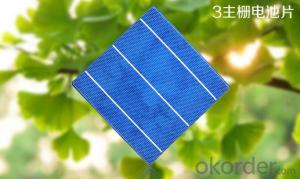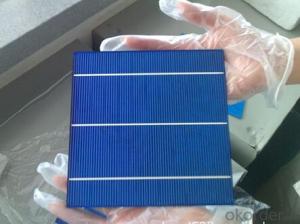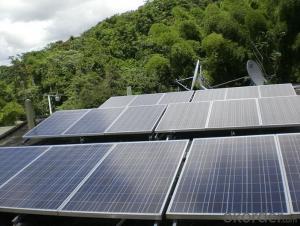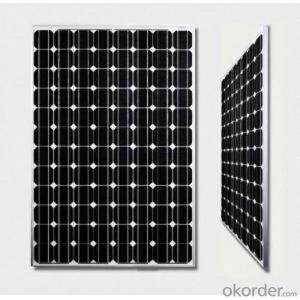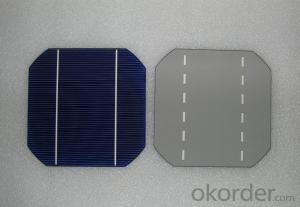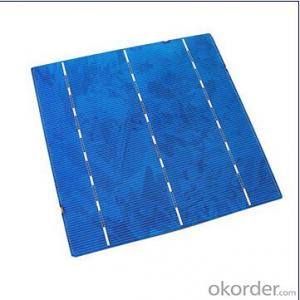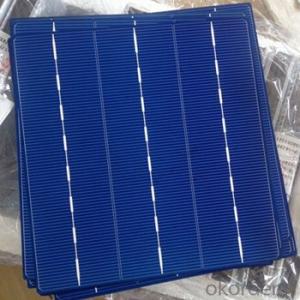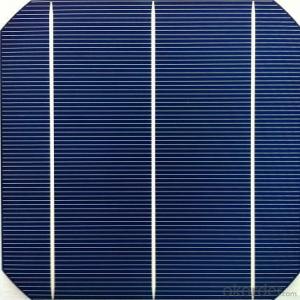Used PV Mono 3BB Solar Cells for Sale
- Loading Port:
- China Main Port
- Payment Terms:
- TT OR LC
- Min Order Qty:
- -
- Supply Capability:
- -
OKorder Service Pledge
OKorder Financial Service
You Might Also Like
Introduction:
We supply regular mono 125x125mm and poly 156x156mm solar cells.
Cells made in China mainland and Taiwan are both available.
Cell production capacity yearly reach 1GW.
Our cells pattern include continuous and uncontinuous busbar to meet different cells line.
THE CHARACTERISTIC OF 156P POLY-SILICON SOLAR CELLS
1.Format 156mm×156mm±0.5mm,Thickness 210μm±30μm.
2.High efficiency in photovoltaic conversion 16.3%~17.93%;
3.Low inverse current, high shunt resistance and high dependability.
4.Front(-): covered by dark blue silicon nitride anti-reflecting coating(silicon nitride) with bus bars(silver), 2/3/5 bud bars(silver).
5.Back(+): wide soldering pads(silver), back surface field(aluminum),high quality paste for the BSF and the electrode ensure higher tension and improve soldering easiness.

- Q: Can solar cells be used for powering concert venues?
- Yes, solar cells can be used for powering concert venues. Solar panels can be installed on the roof or surrounding areas of the venue to capture sunlight and convert it into electricity. This renewable energy source can help reduce the carbon footprint of the venue and provide a sustainable solution for powering concerts.
- Q: Can solar cells be used in public infrastructure projects?
- Yes, solar cells can be used in public infrastructure projects. Solar cells can be integrated into various infrastructure elements such as street lights, bus stops, parking meters, and even road surfaces to generate electricity from sunlight. This sustainable energy source can help reduce reliance on traditional power grids, lower carbon emissions, and promote renewable energy use in public spaces.
- Q: Where and how can we find the best solar cells suppliers?
- The good solar cell supplier won't just show up at your door, you need to dive into the solar cell market and get to know them by visiting the factories.
- Q: How do solar cells perform in coastal environments?
- Solar cells perform well in coastal environments as they are not affected by the presence of salt in the air. However, high humidity levels and salt spray can potentially impact the performance of solar cells over time, requiring regular maintenance and cleaning to ensure optimal efficiency.
- Q: What is the impact of solar cells on reducing water usage?
- Solar cells have a positive impact on reducing water usage as they do not require water for their operation, unlike traditional energy sources such as coal or natural gas power plants. By generating electricity from sunlight, solar cells help conserve water resources that would otherwise be used for cooling and steam production in conventional power generation processes. This reduction in water consumption contributes to conserving this precious resource and mitigating the impacts of water scarcity in regions where water availability is limited.
- Q: Can solar cells be used in public transportation systems?
- Yes, solar cells can be used in public transportation systems. They can be integrated into various components such as the roof or windows of buses, trains, or trams to harness solar energy and power the vehicle's electrical systems, reducing reliance on fossil fuels and lowering carbon emissions. This technology is already being implemented in some cities around the world, offering a more sustainable and environmentally friendly alternative for public transportation.
- Q: How are solar cells manufactured?
- Solar cells are manufactured through a multi-step process that involves the production of silicon wafers, the creation of a p-n junction, and the assembly of various layers to form the final solar cell. This involves slicing the silicon into thin wafers, doping them to create the desired electrical properties, applying metal contacts, and then encapsulating them to protect against environmental factors.
- Q: What are the short-circuit currents of solar cells affected by the factors?
- Silicon cell: the life of the minority after the diffusion, silicon impurity content, silicon chip resistivity, cashmere suede, PE anti-reflective film anti-reflective effect, the front gate line printing and so on affect the short-circuit current.
- Q: What is the maximum efficiency that a solar cell can achieve?
- The maximum efficiency that a solar cell can achieve is known as the Shockley-Queisser limit, which is approximately 33.7%. However, in practical applications, the efficiency of commercial solar cells typically ranges between 15-22%.
- Q: Which brand of the solar cells is sold with the lower price on the market? Which brand is more practical for the countryside?
- The low price solar cells do not always mean lower quality, because sometime the government may provide the tax refund to support saving the energy.
Send your message to us
Used PV Mono 3BB Solar Cells for Sale
- Loading Port:
- China Main Port
- Payment Terms:
- TT OR LC
- Min Order Qty:
- -
- Supply Capability:
- -
OKorder Service Pledge
OKorder Financial Service
Similar products
Hot products
Hot Searches
Related keywords











